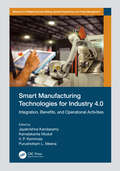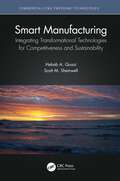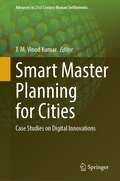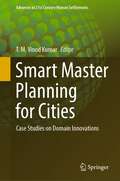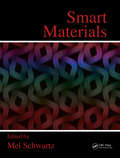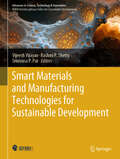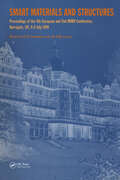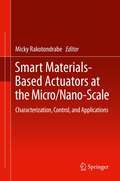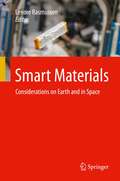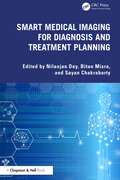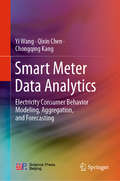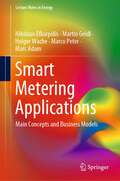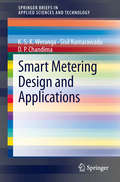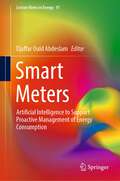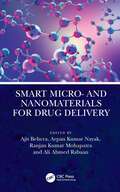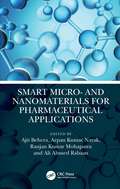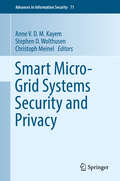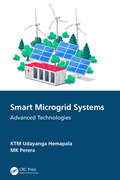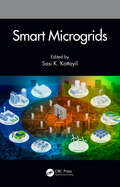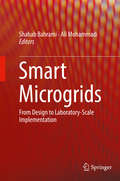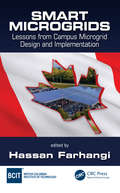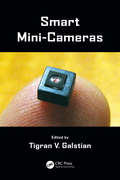- Table View
- List View
Smart Manufacturing Factory: Artificial-Intelligence-Driven Customized Manufacturing
by Jiafu Wan Baotong Chen Shiyong WangArtificial Intelligence (AI) technologies enable manufacturing systems to sense the environment, adapt to external needs, and extract process knowledge, including business models such as intelligent production, networked collaboration, and extended service models. This book therefore focuses on the implementation of AI in customized manufacturing (CM). The main topics include edge intelligence in manufacturing, heterogeneous networks, intelligent fault diagnosis and maintenance, dynamic resource scheduling in manufacturing, and the construction mode of the smart factory. Based on the insights of CM and AI, the authors demonstrate the implementation of AI in the smart factory for CM, including architecture, information fusion, data analysis, dynamic scheduling, flexible production line construction, and smart manufacturing services. This book will provide important research content for scholars in artificial intelligence, smart manufacturing, machine learning, multi-agent systems, and industrial Internet of Things.
Smart Manufacturing Technologies for Industry 4.0: Integration, Benefits, and Operational Activities (Advances in Intelligent Decision-Making, Systems Engineering, and Project Management)
by Jayakrishna Kandasamy Kamalakanta Muduli V. P. Kommula Purushottam MeenaThis book addresses issues related to the integration of digital evolutionary technologies and provides solutions to various challenges encountered during the implementation process. With real-time case studies, the book explains the smart technologies available and their operational applications and benefits in the manufacturing sector. Smart Manufacturing Technologies for Industry 4.0: Integration, Benefits, and Operational Activities assists in the understanding of the shifting paradigm in the manufacturing sector towards smart manufacturing and spotlights these technologies and the effects they are having on existing industries. It showcases Industry 4.0 as a promising research area in its infancy and offers insights into the role smart technologies are playing now and into the future. The book focuses on smart technologies’ rudiments, implementation, and integration for organizational development and offers insights on how to achieve resiliency through and because of these technologies. This book presents real-time implementation discussions along with case studies that emphasize benefits and operational activities for engineers and managers. It’s also a very useful book for technology developers, academicians, data scientists, industrial engineers, researchers, and students interested in uncovering the latest innovations in a field that seeks current research on products and services.
Smart Manufacturing: Integrating Transformational Technologies for Competitiveness and Sustainability (Commercializing Emerging Technologies)
by Hebab A. Quazi Scott M. ShemwellThe manufacturing industries remain the foundation of local, regional, and global economies. Manufacturing plants operate in dynamic markets that demand upgrading with transformational technologies for maintaining profitability, competitiveness, and business sustainability. Yet most manufacturing plants currently use technologies that are no longer competitive, and industry leaders face an overwhelming array of operational challenges that require agile and enhanced transformational solutions. This book offers manufacturers effective strategies and tools for the adoption and implementation of advanced operational technologies to ensure long-term innovation, efficiency, and profitability. Covers advanced automation integration in manufacturing, including digitization, AI, machine learning, IIoT, and cybersecurity Describes innovation, development, and integration of control technologies for sustainable manufacturing Explains how to upgrade existing manufacturing plants for the global market Shows how to apply emerging technologies including asset optimization and process integration for product lifecycle improvements, plant operation and maintenance enhancement, and supply chain integration This book serves as a strategic guide to applying advanced operational technologies for engineers, industry professionals, and management in the manufacturing sector.
Smart Master Planning for Cities: Case Studies on Digital Innovations (Advances in 21st Century Human Settlements)
by T. M. Vinod KumarThis book, based on international collaborative research, presents a state-of-the-art design for “Smart Master Planning” for all metropolises, megacities and metacities as well as at subcity zonal and community and neighborhood level. Smart Master Planning accepts that all cities are a smart city in making in a limited way as far as the six components for smart cities, namely smart people, smart economy, smart environment, smart mobility and smart governance are concerned. Smart Master Planning in any city can only be designed and executed by active roles of smart people and smart city government and is a joint and synchronous effort of e-democracy, e-governance and ICT-IOT system in a 24 hour 7-day framework on all activities. In addition to use of information and communication technologies and remote sensing, the design of Smart Master Planning utilizes domain-specific tools of many aspects of a city to realize the coordinated, effective and efficient planning, management, development and conservation that improve ecological, social, biophysical, psychological and economic wellbeing in an equitable manner without compromising the sustainability of development ecosystems and stakeholders. This book will present 12 case studies covering more than 12 cities or more cities centered on domain-specific smart planning components.Case studies of digital innovations in the Smart Master Planning include Application of Artificial Neural Network in Master Planning for cities, Smart Master Plan and 3 D GIS Planning Support System and Digital Spatial Master Planning Incorporating Machine to Machine Automation for Smart Economic Community (IoT, ICT and M2M based Digital Integration).
Smart Master Planning for Cities: Case Studies on Domain Innovations (Advances in 21st Century Human Settlements)
by T. M. Vinod KumarThis book, based on international collaborative research, presents a state-of-the-art design for “Smart Master Planning” for all metropolises, megacities and meta cities as well as at sub-city zonal and community and neighborhood level. Smart Master Planning accepts that all cities are a smart city in making in a limited way as far as the six components for Smart Cities; namely, smart people, smart economy, smart environment, smart mobility and smart Governance are concerned. Smart Master Planning in any city can only be designed and executed by active roles of Smart People and Smart City Government and is a joint and synchronous effort of E-Democracy, E-Governance and ICT-IOT system in a 24 hour 7-day framework on all activities. In addition to use of Information and Communication Technologies, and Remote Sensing, the design of smart Master Planning utilizes domain specific tools of many aspects of a city to realize the coordinated, effective and efficient planning, management, development and conservation that improve ecological, social, biophysical, psychological and economic well-being in an equitable manner without compromising the sustainability of development ecosystems and stakeholders. This book will present 12 case studies covering more than 12 cities or more cities centered on domain-specific smart planning components.Case studies of Domain Innovations include Urban Land management, Master Planning for Water Management, Comprehensive Master Planning Innovations, Smart Use of Master Plan basics, Integrated Smart Master Planning, and Citizen-Centric Master Planning.
Smart Materials
by Mel SchwartzExplores State-of-the-Art Work from the World's Foremost Scientists, Engineers, Educators, and Practitioners in the FieldWhy use smart materials?Since most smart materials do not add mass, engineers can endow structures with built-in responses to a myriad of contingencies. In their various forms, these materials can adapt to their environments by c
Smart Materials and Manufacturing Technologies for Sustainable Development (Advances in Science, Technology & Innovation)
by Vijeesh Vijayan Rashmi P. Shetty Srinivasa P. PaiThis book offers a comprehensive exploration of " Smart Materials and Manufacturing Technologies for Sustainable Development “delves into the dynamic intersection of innovative materials, intelligent manufacturing, and sustainable practices, presenting a vital resource for researchers, engineers, and professionals seeking to shape a greener and more advanced future. Covering a wide range of topics, the book delves into the latest advancements in materials processing, with a particular focus on cutting-edge technologies such as advanced manufacturing, nanotechnology, and materials. The book addresses the pressing need for sustainable manufacturing practices, unveiling eco-friendly approaches that reduce environmental impact without compromising performance. Chapters dedicated to artificial intelligence and machine learning illuminate how these game-changing technologies facilitate manufacturing, materials characterization, and process optimization. By integrating IoT, Industry 4.0, robotics, and automation, this book highlights the growing synergy between intelligent manufacturing and sustainable materials, paving the way for increased efficiency and productivity. It examines the importance of advanced materials characterization techniques, empowering researchers to gain deeper insights into materials' properties, behaviour, and potential applications. With its multidisciplinary approach, this book appeals to a diverse audience, including materials scientists, manufacturing engineers, environmentalists, policymakers, and students eager to contribute to a more sustainable and technologically advanced society.
Smart Materials and Structures: Proceedings of the 4th European and 2nd MIMR Conference, Harrogate, UK, 6-8 July 1998
by G R Tomlinson W A BulloughSignificant changes have occurred in materials science, including increasing demands on life extensions, and the reliability and exploitability of components, materials, and structures. These changes provide smart technologies with excellent application opportunities in aerospace, civil and electrical engineering, transportation, manufacturing, com
Smart Materials and Technologies in Architecture: For The Architecture And Design Professions
by Daniel Schodek Michelle AddingtonToday, architects and designers are beginning to look toward developments in new"smart" or "intelligent" materials and technologies for solutions to long-standing problemsin building design. However, these new materials have so far been applied in a diversebut largely idiosyncratic nature, because relatively few architects have access toinformation about the types or properties of these new materials or technologies.Two of the leading experts in this field - Addington and Schodek - have solved thisproblem by incorporating all the relevant information of all the latest technologiesavailable to architects and designers in this one volume. They present materials bydescribing their fundamental characteristics, and go on to identify and suggest howthese same characteristics can be exploited by professionals to achieve their designgoals. Here, the wealth of technical understanding already available in the materialsscience and engineering literature is at last made accessible to a design audience.
Smart Materials for Science and Engineering
by Upendra Kumar Piyush Kumar SonkarSMART MATERIALS FOR SCIENCE AND ENGINEERING Smart materials, also known as advanced or creative materials, are described as advanced materials that react intuitively to environmental changes or as materials that can return to their original shape in response to certain stimuli. Smart materials are classified as either active or passive based on their characteristics. There are two types of active materials. The first kind cannot change its characteristics when subjected to outside stimuli, for example photochromatic spectacles that only alter their color when exposed to sunlight. The other, which includes piezoelectric materials, can change one sort of energy (thermal, electrical, chemical, mechanical, or optical) into another. When subjected to external pressure, it can generate an electric charge. As an example, optical fibers can transmit electromagnetic waves. In contrast, passive smart materials can transmit a specific sort of energy. They have some amazing qualities that set them apart from other materials, such as transiency, meaning they can react to different kinds of external stimuli immediately, self-actuation or the capacity to change their appearance and shape, selectivity where the response is divided and expected, directness when the response is limited to the activating event, shape-changing where the material can change its shape to external stimuli, their ability to determine their own health, also known as self-diagnosis, and their ability to self-heal. The ability to synthesize novel materials has substantially progressed thanks to science and technology over the past 20 years. They fall mostly into the following four categories: polymers, ceramics, metals, and smart materials. Among these, smart materials are gaining popularity since they have more uses than conventional materials. Smart materials are unusual substances that have the ability to alter their properties, such as those that can immediately change their phase when placed near a magnet or their shape simply by applying heat. Humanity will be significantly impacted by this new era of smart materials. For instance, some of them can adapt their properties to the environment, some have sensory capabilities, some can repair themselves automatically, and some can degrade themselves. These extraordinary properties of smart materials will have an effect on all facets of civilization. There are many different types of intelligent materials, including magnetorheological materials, electro-rheostat materials, shape memory alloys, piezoelectric materials, and more. This book describes many forms of smart materials and their possible uses in various fields. A literature survey discusses the different types of smart materials, such as based ceramics, polymers, and organic compounds and their needs, advantages, disadvantages, and applications will be comprehensively discussed. A discussion of well-established smart materials including piezoelectric, magnetostrictive, shape memory alloy, electro-rheological fluid, and magnetorheological fluid materials will be discussed with their present prospects.
Smart Materials-Based Actuators at the Micro/Nano-Scale: Characterization, Control, and Applications
by Micky RakotondrabeSmart Materials-Based Actuators at the Micro/Nano-Scale: Characterization, Control, and Applications gives a state of the art of emerging techniques to the characterization and control of actuators based on smart materials working at the micro/nano scale. The book aims to characterize some commonly used structures based on piezoelectric and electroactive polymeric actuators and also focuses on various and emerging techniques employed to control them. This book also includes two of the most emerging topics and applications: nanorobotics and cells micro/nano-manipulation.
Smart Materials: Considerations on Earth and in Space
by Lenore RasmussenThis book provides in-depth coverage of smart materials, including electroactive polymers (EAPs), synthetic muscle, pneumatic artificial muscle, soft pneumatics, hydro-muscle, and other cutting-edge transformational smart material technologies. It looks at ways smart materials respond to stimuli, such as electricity, pressure, temperature, magnetism, or light. State-of-the-art developments in EAP based actuation and pneumatics are covered, including nanotechnology, soft robotics, EAP considerations for NASA applications and thermal control of satellites, control of mirrors using dielectric elastomeric actuators, and biomimetic design and function in robotics and prosthetics. A detailed analysis of the challenges of smart materials on Earth and in space is included, with an interview about considerations and training for Missions to Moon and Mars. This book is a must-read within the smart material and space communities, from tech savvy students to industry professionals.
Smart Medical Imaging for Diagnosis and Treatment Planning
by Nilanjan Dey, Bitan Misra, and Sayan ChakrabortyThis book presents advanced research on smart health technologies, focusing on the innovative transformations in diagnosis and treatment planning using medical imaging and data analysed by data science techniques. It shows how smart health technologies leverage artificial intelligence (AI) and big data analytics to provide more accurate and efficient diagnosis and treatment planning. In search for innovative and novel methods and techniques for health technologies and medical data processing, the book • Discusses applications of Artificial Intelligence, Data Science, Machine Learning, Deep Learning, the Internet of Things, Big Data, Cloud Computing;• Includes use of electronic patient records in healthcare, analysis of big data in medical diagnosis, reliability, and challenges of EPR and EHR in smart healthcare;• Explores evolving techniques for smart healthcare, its application in medical imaging and prediction in the fields of treatment planning;• Provides recent studies in AI-driven healthcare technologies and medical imaging to outline insight into smart healthcare technologies;• Discusses the role of big data in smart healthcare, computing techniques for healthcare for medical diagnosis and treatment planning;• Encompasses the ethical and legal challenges of using smart healthcare and medical data.This book serves as a valuable reference for researchers working on smart health technologies. Researchers of medical imaging, artificial intelligence, and data science along with healthcare domain will find it a great resource as well.
Smart Meter Data Analytics: Electricity Consumer Behavior Modeling, Aggregation, and Forecasting
by Yi Wang Chongqing Kang Qixin ChenThis book aims to make the best use of fine-grained smart meter data to process and translate them into actual information and incorporated into consumer behavior modeling and distribution system operations. It begins with an overview of recent developments in smart meter data analytics. Since data management is the basis of further smart meter data analytics and its applications, three issues on data management, i.e., data compression, anomaly detection, and data generation, are subsequently studied. The following works try to model complex consumer behavior. Specific works include load profiling, pattern recognition, personalized price design, socio-demographic information identification, and household behavior coding. On this basis, the book extends consumer behavior in spatial and temporal scale. Works such as consumer aggregation, individual load forecasting, and aggregated load forecasting are introduced. We hope this book can inspire readers to define new problems, apply novel methods, and obtain interesting results with massive smart meter data or even other monitoring data in the power systems.
Smart Metering Applications: Main Concepts and Business Models (Lecture Notes in Energy #88)
by Nikolaos Efkarpidis Martin Geidl Holger Wache Marco Peter Marc AdamThis book presents a large number of smart metering applications from the points of view of different stakeholders.The applications are clustered with respect to three types of stakeholders: (a) end-customers, (b) energy service providers, and (c) authorities/research institutions or other organizations. The goal of the book is to examine the implementation potential for each application, considering the interests and benefits for the key stakeholders, main technical and regulatory requirements, as well as limitations and barriers. A business case for each application is created that can provide guidelines to the stakeholders involved in its realization.The book additionally investigates current business models for smart metering applications. A survey on the current techno-economic potential of such applications is conducted based on a questionnaire filled by various stakeholders.The book will be of interest to academic/research institutions, but also engineers in industry, authorities or other organizations.
Smart Metering Design and Applications
by K.S.K Weranga Sisil Kumarawadu D. P. ChandimaTaking into account the present day trends and the requirements, this Brief focuses on smart metering of electricity for next generation energy efficiency and conservation. The contents include discussions on the smart metering concepts and existing technologies and systems as well as design and implementation of smart metering schemes together with detailed examples.
Smart Meters: Artificial Intelligence to Support Proactive Management of Energy Consumption (Lecture Notes in Energy #97)
by Djaffar Ould AbdeslamThis book describes how equipping buildings with smart meters is essential to improve the prediction of energy costs within smart grids and to help end-users optimize their energy consumption. The book reports on the results of the European Upper Rhine INTERREG project SMI (www.smi.uha.fr), which connects artificial intelligence and micro-societal analysis. It is multidisciplinary and addresses the following aspects: social, legal, environmental, and technical.One of the critical factors for the transition to clean energy is the flexibility of the power grid. A flexible grid requires a constant flow of data about the network and its demand, on the other hand, clients who produce electrical power can be an active part of the demand response if they are informed about the power needs of their appliances.“If you cannot measure it, you cannot improve it.” This common management saying also holds true for the area energy efficiency. Without a clear understanding of their energy usage, consumers are unable to take steps to reduce their consumption. A new intelligent tool is presented that is more efficient, safe, and acceptable to consumers. Thus, users of this intelligent tool will be able to collect and predict the consumption of their electrical appliances. At the same time, the consumption information is anonymized before being relayed to the energy supplier. In parallel, new techniques will be evaluated to improve the security level of the smart meter in a highly heterogeneous network.
Smart Micro- and Nanomaterials for Drug Delivery (Emerging Materials and Technologies)
by Ajit Behera Arpan Kumar Nayak Ranjan K. Mohapatra Ali Ahmed RabaanSmart drug delivery at both the micro- and nanoscale is an evolving field with numerous potential applications. It has the potential to revolutionize drug therapy by making treatments more effective, reducing side effects, and improving patient outcomes.This book presents a comprehensive review of the most recent studies on smart micro- and nanomaterials with a focus on their “smart” activity for formation of targeted and responsive drug-delivery carriers. This volume: Introduces readers to the fundamentals of these the micro- and nanoscale materials as well as approaches to smart drug delivery and drug delivery systems. Covers polymers, metals, and composite materials as well as quantum dots and carbon nanotubes. Describes of all possible stimulated systems for drug delivery such as enzyme-responsive, small molecules-responsive, thermo-responsive, pH-responsive, electric field-responsive, magnetic field-responsive, light-responsive, ultrasound-responsive, and reductive environment responsive. Offers a critical perspective on the future scope of smart drug delivery systems. This reference work is written to support researchers in the fields of materials engineering and biotechnology with the goal of improving the diagnosis and treatment of disease and patient quality of life.
Smart Micro- and Nanomaterials for Pharmaceutical Applications (Emerging Materials and Technologies)
by Ajit Behera Arpan Kumar Nayak Ranjan K. Mohapatra Ali Ahmed RabaanSmart drug delivery refers to a targeted drug delivery or precision drug delivery system that allows drugs to be administered to a specific location in the body or at a specific time with enhanced precision and control. This approach has several advantages, including maximizing the therapeutic effects of a drug while minimizing side effects.This book presents various stimuli-responsive micro- and nanomaterials for pharmaceutical industries. This volume: Covers the global market perspective of micro- and nano-smart materials in pharmaceutical industries. Details various processing routes. Discusses mechanisms for target release. Addresses applications in oral drug delivery, anticancer agents, anti-tumor drug delivery, and drugs for management of infection. This reference work is written to support researchers in the fields of materials engineering and biotechnology with the goal of improving the diagnosis and treatment of disease and patient quality of life.
Smart Micro-Grid Systems Security and Privacy (Advances in Information Security #71)
by Christoph Meinel Anne V. Kayem Stephen D. WolthusenThis book is centered on Smart grids and micro-grids, as a cost-effective method of ensuring fair and equitable access to power in urban areas. It also considers scenarios where deploying smart grids can be both cost-prohibitively expensive and logistically challenging. Deploying smart microgrids instead, offers a reliable power solution but, as is the case in smart grids, a key issue is guaranteeing usability, trust, and reliability while protecting against energy theft. This book considers aspects such as state estimation, capacity planning, demand forecasting, price signals, and demand management with respect to energy theft. Straight-forward approaches to provoking energy theft on smart grids and micro-grids include mis-recordings power consumption/generation information and exposures of personally identifiable information or sensitive information. Attack models based on mis-recorded generation and/or consumption data and exposure of personally identifiable information, are also studied. In each case, countermeasures are proposed to circumvent the power theft attacks raised. Researchers in Smart Micro-grids security, cyber-physical systems, and critical infrastructure will want to purchase this book as a reference. Professionals, Researchers, Academics and students working in security general and Security of Critical Infrastructure, Privacy, and Data Sharing will also want to purchase this book as a reference.
Smart Microgrid Systems: Advanced Technologies
by KTM Udayanga Hemapala MK PereraThis book highlights microgrids as integrating platforms for distributed generation units, energy storages and local loads, with an emphasis on system performance via innovative approaches. It explains the smart power system concept, transmission, distribution, and utilization, and then looks at distributed generation technologies and hybrid power systems. Smart approaches, an analysis of microgrid design architecture and its implementation, the mitigation of cyber threats, and system optimization are also included. Case studies related to microgrid modeling and simulation are placed at the end of each chapter. FEATURES Focuses on applications of expert systems for microgrid control Explores microgrid applications for power networks and applications of expert technologies Reviews design and development technologies related to renewable energy for a weak power network Discusses cyber security for microgrids Includes case studies related to actual developments and research This book is aimed at researchers and graduate students in power engineering and electronics.
Smart Microgrids
by Sasi K. KottayilThis book addresses the need to understand the development, use, construction, and operation of smart microgrids (SMG). Covering selected major operations of SMG like dynamic energy management, demand response, and demand dispatch, it describes the design and operational challenges of different microgrids and provides feasible solutions for systems. Smart Micro Grid presents communication technologies and governing standards used in developing communication networks for realizing various smart services and applications in microgrids. An architecture facilitating bidirectional communication for smart distribution/microgrid is brought out covering aspects of its design, development and validation. The book is aimed at graduate, research students and professionals in power, power systems, and power electronics. Features: • Covers a broad overview of the benefits, the design and operation requirements, standards and communication requirements for deploying microgrids in distribution systems. • Explores issues related to planning, expansion, operation, type of microgrids, interaction among microgrid and distribution networks, demand response, and the technical requirements for the communication network. • Discusses current standards and common practices to develop and operate microgrids. • Describes technical issues and requirements for operating microgrids. • Illustrates smart communication architecture and protocols.
Smart Microgrids: From Design to Laboratory-Scale Implementation
by Shahab Bahrami Ali MohammadiIn this book the authors first provide a comprehensive survey on the available studies on control, management, and optimization strategies in AC and DC microgrids. The authors then provide the design of a laboratory-scale microgrid system. Finally, a real-world implementation of the deigned framework is provided. This book paves the way for researchers working on the smart microgrids spread over the fields of electrical engineering, power systems, and smart infrastructures. Furthermore, it provides the readers with a comprehensive insight to understand an in-depth big picture of smart microgrids as well as an all-inclusive framework for laboratory-scale implementation of a microgrid. It is suitable for senior undergraduate students, graduate students who are interested in research in areas related to future smart grids and microgrids, and the researchers working in the related areas. This book also can be used as a reference book for researchers who want to develop laboratories on smart microgrids for future research.
Smart Microgrids: Lessons from Campus Microgrid Design and Implementation
by Russell L. HermanThe utility sector’s transition to renewable energy and the smart grid has already begun. The first step towards smart grid is microgrid, which is a smaller electricity grid with access to all the essential assets of a larger grid. This book provides a glimpse into an actual microgrid project. It supplies a system-level approach to the design of smart Microgrids, covering the entire design process—from roadmap to realization. Detailing lessons learned and pitfalls to avoid in Microgrid technology, the book provides an interdisciplinary approach to design and problem solving for smart microgrids.
Smart Mini-Cameras
by Tigran V. GalstianAchieve the Best Camera Design: Up-to-Date Information on MCMsMiniature camera modules (MCMs), such as webcams, have rapidly become ubiquitous in our day-to-day devices, from mobile phones to interactive TV systems. MCMs-or "smart" cameras-can zoom, adjust their frame rate automatically with illumination change, focus at different distances, compen

